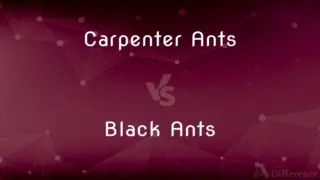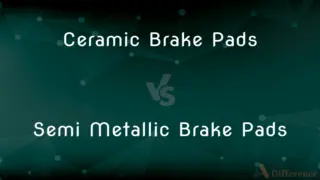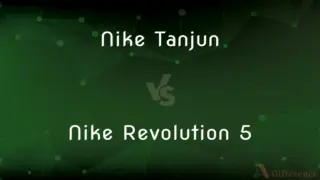Polyester vs. Polycotton — What's the Difference?
Edited by Tayyaba Rehman — By Maham Liaqat — Updated on May 3, 2024
"Polyester" is a synthetic fabric known for durability and resistance to shrinking and stretching, whereas "polycotton" is a blend of polyester and cotton that combines the qualities of both materials.

Difference Between Polyester and Polycotton
Table of Contents
ADVERTISEMENT
Key Differences
Polyester is a wholly synthetic material known for its strength, durability, and resistance to environmental conditions like moisture and wrinkles. On the other hand, polycotton blends polyester with natural cotton fibers, aiming to leverage the benefits of both synthetic and natural properties.
The durability and easy maintenance of polyester make it a popular choice for various applications, from clothing to furnishings. In contrast, polycotton is valued for providing a balance between comfort and functionality, offering improved breathability over pure polyester due to the cotton content.
Polyester fabric is less breathable compared to natural fibers, which can make it less comfortable for wear in hot weather. Polycotton, with its cotton component, allows for better air circulation, making garments more comfortable in diverse climates.
A significant advantage of polyester is its high resistance to shrinking and stretching, ensuring garments maintain their shape over time. Meanwhile, polycotton also resists these issues better than pure cotton, though not quite as effectively as 100% polyester.
In terms of cost, pure polyester is often more affordable than polycotton. This cost-effectiveness, along with its durability, makes polyester a widely used fabric in the budget and mass production sectors. Polycotton, though generally more expensive than pure polyester, offers a softer feel and a more balanced approach to fabric characteristics.
ADVERTISEMENT
Comparison Chart
Composition
100% synthetic fibers
Blend of synthetic polyester and natural cotton
Breathability
Lower, less breathable
Higher than polyester due to cotton
Durability
Very high, resistant to shrinking and stretching
High, but less than pure polyester
Comfort
Less comfortable in heat, can feel clammy
More comfortable than polyester, less than pure cotton
Cost
Generally less expensive
More expensive than polyester, cheaper than pure cotton
Compare with Definitions
Polyester
Resistant to wrinkles and does not require ironing.
She packed the polyester dress because it wouldn’t wrinkle in her suitcase.
Polycotton
A blend that combines the strength of polyester with the comfort of cotton.
The polycotton sheets were both soft and durable, perfect for regular use.
Polyester
A durable, synthetic fabric resistant to environmental damages.
The polyester curtains resisted fading despite years of sun exposure.
Polycotton
Commonly used in bedding and uniforms for balanced comfort and durability.
The hotel chose polycotton linens for their rooms to ensure guest comfort and ease of maintenance.
Polyester
Often used in outdoor and performance gear.
The hikers preferred polyester jackets for their water-resistant properties.
Polycotton
Resistant to shrinking, more so than pure cotton.
After several washes, the polycotton T-shirts maintained their size and shape.
Polyester
Can be less breathable and trap body heat.
The runner found his polyester gear too warm for the summer marathon.
Polycotton
Generally offers a good balance between cost and performance.
The school uniforms were made of polycotton to withstand frequent washing and daily wear.
Polyester
Known for being low maintenance and quick drying.
His polyester shirt dried quickly after a wash, ready to wear again.
Polycotton
Offers better breathability than polyester, ideal for clothing.
Her polycotton blouse was comfortable enough for both the office and outdoor events.
Polyester
Polyester is a category of polymers that contain the ester functional group in every repeat unit of their main chain. As a specific material, it most commonly refers to a type called polyethylene terephthalate (PET).
Polycotton
A fabric made from a blend of cotton and artificial fibres, especially of polyester fibres
Polyester
A synthetic resin in which the polymer units are linked by ester groups, used chiefly to make synthetic textile fibres.
Polyester
Any of numerous synthetic polymers produced chiefly by reaction of dicarboxylic acids with dihydric alcohols and used primarily as light, strong, weather-resistant resins in boat hulls, textile fibers, adhesives, and molded parts.
Polyester
A wrinkle-resistant fabric of fibers made from any of these resins.
Polyester
Any polymer whose monomers are linked together by ester bonds
Polyester
A material or fabric made from polyester polymer
Polyester
Of, or consisting of polyesters
Polyester
Any of numerous synthetic resins; they are light and strong and weather resistant
Polyester
A complex ester used for making fibers or resins or plastics or as a plasticizer
Polyester
Any of a large class of synthetic fabrics
Common Curiosities
Can polycotton fabrics be used for outdoor applications?
Yes, though they're not as durable or moisture-resistant as 100% polyester.
Why might someone choose polycotton over polyester?
For a better balance of comfort and durability, especially in clothing and bedding.
Which fabric is easier to care for, polyester or polycotton?
Polyester is easier to care for as it requires less ironing and dries faster.
Is polyester suitable for all types of clothing?
While versatile, it's less ideal for very hot climates due to its lower breathability.
How does the cost of polycotton compare to pure cotton?
Polycotton is generally cheaper than pure cotton but offers some of cotton's desirable properties.
Are there environmental concerns associated with polyester?
Yes, as a synthetic material, polyester is not biodegradable and its production is energy-intensive.
Why might a business choose polyester for uniforms?
For its durability, ease of maintenance, and cost-effectiveness, especially in high-use scenarios.
What are the washing instructions for polyester?
Polyester can generally be machine washed and dried, but avoiding high temperatures is recommended to prevent damage.
Can polycotton shrink or fade?
It can, but at a much lower rate than pure cotton, especially if care instructions are followed.
What are the primary benefits of polyester?
Durability, resistance to environmental factors like moisture and wrinkles, and cost-effectiveness.
Does the ratio of polyester to cotton in polycotton affect its properties?
Yes, higher polyester content increases durability and moisture resistance, while more cotton improves comfort and breathability.
What is the ideal use of polycotton in household items?
In items like bed linens and tablecloths where balance between durability and comfort is needed.
How do consumers typically respond to the feel of polyester versus polycotton?
Consumers often find polycotton to feel softer and more natural compared to polyester.
What are some common misconceptions about polyester?
That it is always uncomfortable and cheap-looking, which is not necessarily true with modern polyester fabrics.
What advancements have been made in polyester and polycotton fabrics?
Advances include improved breathability, aesthetic qualities, and eco-friendly production methods.
Share Your Discovery

Previous Comparison
How vs. Why
Next Comparison
Cable vs. DSLAuthor Spotlight
Written by
Maham LiaqatEdited by
Tayyaba RehmanTayyaba Rehman is a distinguished writer, currently serving as a primary contributor to askdifference.com. As a researcher in semantics and etymology, Tayyaba's passion for the complexity of languages and their distinctions has found a perfect home on the platform. Tayyaba delves into the intricacies of language, distinguishing between commonly confused words and phrases, thereby providing clarity for readers worldwide.















































